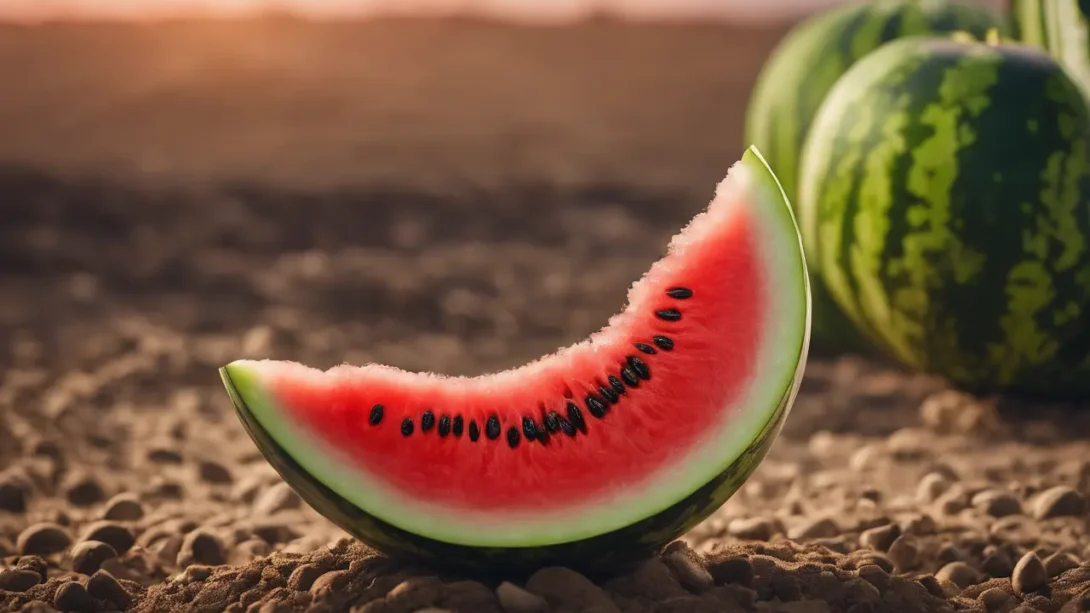Watermelon (Citrullus lanatus) cultivation is a rewarding endeavor for many gardeners, offering the joy of growing large, succulent fruits that are perfect for summer refreshments. Understanding the germination process of watermelon seeds is crucial for ensuring a successful crop. Generally, watermelon seeds take about 7 to 14 days to germinate under optimal conditions. This article will delve into the intricacies of watermelon seed germination, outlining the factors that influence it and providing guidance on how to create the ideal environment for your seeds to sprout.
Watermelon Seed Germination
Germination is the process by which a seed emerges from its dormant state and begins to grow into a new plant. For watermelon seeds, this process involves the absorption of water through the seed coat, triggering the embryo inside to start growing. Several factors can affect the germination of watermelon seeds, including temperature, moisture, seed depth, and soil type.
- Temperature: Watermelon seeds require warm conditions to germinate. The ideal temperature range is between 70°F to 95°F (21°C to 35°C). Temperatures outside this range can significantly slow down germination or prevent it altogether.
- Moisture: Consistent moisture is essential for germination. The soil should be kept moist but not waterlogged, as too much water can cause the seeds to rot.
- Seed Depth: Planting depth can influence germination rates. Watermelon seeds should be planted about 1 inch (2.5 cm) deep, allowing for adequate moisture retention and easy emergence of the seedlings.
- Soil Type: Well-draining soil enriched with organic matter is ideal for watermelon cultivation. The soil should be loose and fertile, promoting easy root growth and access to nutrients.
Optimal Conditions for Germination
Creating the right environment for your watermelon seeds can significantly enhance their chances of germinating successfully. Here are some tips to achieve optimal conditions:
- Temperature Control: Use a heat mat or place your planting container in a warm location to maintain the soil temperature within the ideal range. Nighttime temperatures should not drop below 70°F (21°C) for best results.
- Moisture Management: Water the soil gently to keep it moist. Using a spray bottle can help avoid dislodging the seeds or creating too wet conditions. Covering the pots with plastic wrap can help retain moisture, but be sure to remove it once you see sprouts.
- Soil Preparation: Choose a high-quality, well-draining potting mix or prepare your garden soil by incorporating plenty of compost or aged manure. This will ensure your seeds have the nutrients they need to grow strong and healthy.
Germination Timeframe
The journey from seed to sprout is an exciting phase in watermelon cultivation. Under the ideal conditions outlined previously, watermelon seeds typically begin to germinate within 7 to 14 days. However, this timeframe can vary based on the specific conditions in your garden, including variations in soil temperature and moisture levels. Some seeds may sprout earlier if they are kept consistently warm and moist, while others might take a bit longer, especially if environmental conditions are not optimal.
It’s important for gardeners to understand this variability and remain patient. Observing the progress of your seeds and making adjustments as needed to temperature and moisture can help ensure successful germination.
Steps to Germinate Watermelon Seeds
To maximize your success rate, follow these steps to germinate watermelon seeds effectively:
- Preparing the Soil or Starting Mix: Whether you’re starting seeds indoors in pots or directly in the garden, choose a well-draining, nutrient-rich soil or starting mix. If planting in pots, fill them with the soil mix, leaving some space at the top.
- Planting Depth and Spacing: Plant watermelon seeds about 1 inch (2.5 cm) deep. If planting in pots, you can start with 2-3 seeds per pot and thin out to the strongest seedling later. In garden beds, space seeds about 18 inches (45 cm) apart in rows, which should be spaced about 5 feet (1.5 meters) apart to accommodate the sprawling growth of watermelon vines.
- Watering and Temperature Control: After planting, water the seeds gently to moisten the soil without causing erosion. If starting seeds indoors, consider using a heat mat to maintain a consistent soil temperature. Outdoors, choose a planting time when the soil has warmed up to at least 70°F (21°C).
- Monitoring and Adjusting Environmental Conditions: Keep the soil consistently moist but not waterlogged. Use a thermometer to check soil temperature regularly, especially if the weather is unpredictable. Adjust watering based on rainfall and temperature changes.
Troubleshooting Common Germination Issues
Even with the best preparation, you might encounter some challenges. Here are solutions to common germination issues:
- Overwatering and Underwatering: If seeds are too wet, they may rot. Ensure proper drainage in pots and beds and adjust watering practices. Conversely, if seeds are too dry, they won’t germinate. Keep the soil moist but not saturated.
- Temperature Extremes: If temperatures are too low, germination will be slow or halted. Use a heat mat or cloches to keep seeds warm. If temperatures are too high, seeds may become dormant. Provide shade or wait for cooler weather.
- Poor or Uneven Germination: This could be due to old or improperly stored seeds, extreme soil conditions, or planting depth issues. Ensure seeds are fresh, conditions are within the optimal range, and seeds are planted at the correct depth.
Transitioning from Germination to Seedling Growth
Once your watermelon seeds have germinated, you’ll notice the first set of true leaves developing, a sign that your seedlings are ready to start their next phase of growth. This stage is crucial, as the young plants are still delicate and require careful attention to thrive.
- Signs of Successful Germination: Look for the emergence of the seedling’s cotyledons, or the first pair of leaves. These are not the true leaves but are an indicator that the seed has sprouted. The appearance of the first true leaves, which will look different from the cotyledons, signifies that the plant is ready for more intense light and possibly transplanting.
- Care Tips for Newly Germinated Seedlings: Provide your watermelon seedlings with plenty of light — if indoors, a south-facing window or grow lights can fulfill their needs. Continue to monitor soil moisture, keeping it consistently moist but not waterlogged. Begin to harden off seedlings by gradually exposing them to outdoor conditions over a week or two before transplanting to reduce shock.
- When and How to Transplant Watermelon Seedlings Outdoors: Wait until all danger of frost has passed and the soil temperature has reached at least 70°F (21°C). Choose a sunny, well-draining location in your garden. If you started seeds in pots, transplant them carefully to avoid disturbing the roots. Space the plants about 2 to 3 feet apart in rows that are 5 to 6 feet apart. Water immediately after transplanting to help settle the soil around the roots.
FAQs
Q: Can I speed up watermelon seed germination?
A: Soaking seeds for 24 hours before planting can help speed up germination. Ensure that the soil temperature is within the ideal range (70°F to 95°F) to encourage quicker sprouting.
Q: Why didn’t my watermelon seeds germinate?
A: Common reasons include planting seeds too deep, incorrect soil temperature, too much or too little water, or old seeds. Check these factors and try adjusting your methods.
Q: How many watermelons can one plant produce?
A: Depending on the variety, a single watermelon plant can produce between 2 to 4 fruits. Proper care and favorable growing conditions are essential for maximizing yield.
Conclusion
Understanding the germination process of watermelon seeds and providing the optimal conditions for your seeds to sprout is the first step towards a successful harvest. From ensuring the right soil temperature and moisture to troubleshooting common issues, each phase in the life cycle of a watermelon plant requires attention and care. With patience and attentiveness, you can guide your watermelon plants through their delicate germination phase into robust, fruit-bearing vines.
Remember, gardening is a learning experience filled with both challenges and rewards. By starting your watermelon cultivation journey with a strong foundation in seed germination, you’re setting the stage for a fruitful and enjoyable gardening season.




